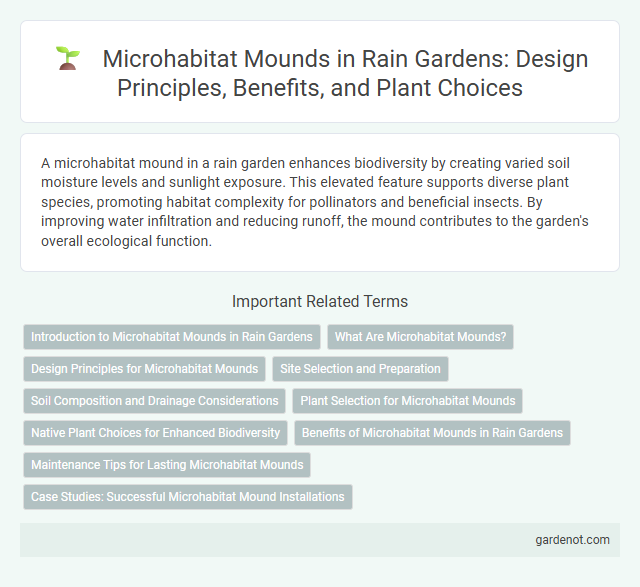A microhabitat mound in a rain garden enhances biodiversity by creating varied soil moisture levels and sunlight exposure. This elevated feature supports diverse plant species, promoting habitat complexity for pollinators and beneficial insects. By improving water infiltration and reducing runoff, the mound contributes to the garden's overall ecological function.
Introduction to Microhabitat Mounds in Rain Gardens
Microhabitat mounds in rain gardens create elevated planting areas that enhance water infiltration and provide diverse soil conditions, supporting a variety of native plants and beneficial insects. These mounds improve drainage by directing excess water away from sensitive root zones while promoting habitat complexity for pollinators and small wildlife. Incorporating microhabitat mounds optimizes rain garden functionality by combining stormwater management with ecological benefits.
What Are Microhabitat Mounds?
Microhabitat mounds are elevated soil structures within rain gardens that create diverse environmental conditions for plants and wildlife. These mounds enhance water drainage and retention, promoting the growth of moisture-loving and drought-tolerant species by offering varied microclimates. Incorporating microhabitat mounds increases biodiversity and supports ecosystem resilience in urban stormwater management systems.
Design Principles for Microhabitat Mounds
Microhabitat mounds in rain gardens are designed to create diverse environmental conditions by varying soil composition, moisture levels, and elevation to support a wide range of plant and animal species. Key design principles include using layered substrates such as sandy soil atop clay to enhance drainage, incorporating native vegetation to promote local biodiversity, and shaping mounds to maximize sun exposure and shelter from wind. The strategic placement of microhabitat mounds improves ecological function by providing habitat heterogeneity and aiding stormwater retention and filtration.
Site Selection and Preparation
Site selection for a microhabitat mound within a rain garden requires assessing soil permeability, sunlight exposure, and topography to ensure optimal drainage and plant growth. Preparation involves removing existing vegetation, amending soil with organic matter to enhance nutrient retention, and sculpting the mound to create varied elevations that support diverse flora and microfauna. Proper placement and soil conditioning improve water infiltration and promote ecological resilience in urban stormwater management.
Soil Composition and Drainage Considerations
Microhabitat mounds in rain gardens require a carefully balanced soil composition combining sandy loam with organic matter to enhance nutrient retention and support diverse plant roots. Proper drainage is critical, achieved by layering coarse materials beneath the soil to prevent waterlogging while maintaining moisture for microhabitat species. These design principles optimize water infiltration and create ideal soil conditions for native plants and beneficial microorganisms.
Plant Selection for Microhabitat Mounds
Plant selection for microhabitat mounds in rain gardens enhances biodiversity and supports specific wildlife needs by incorporating native species adapted to varying moisture levels and soil conditions. Combining deep-rooted plants like switchgrass (Panicum virgatum) with moisture-tolerant species such as sedges (Carex spp.) creates a resilient microenvironment that improves water filtration and provides habitat diversity. Prioritizing native wildflowers and shrubs not only stabilizes soil on mounds but also attracts pollinators and beneficial insects, optimizing ecological function within rain garden systems.
Native Plant Choices for Enhanced Biodiversity
Microhabitat mounds in rain gardens support diverse native plant species such as Echinacea purpurea, Asclepias tuberosa, and Carex pensylvanica, which attract pollinators like bees and butterflies while improving soil health. These native plants provide critical habitat and food resources for local wildlife, enhancing ecosystem resilience and increasing overall biodiversity in urban landscapes. Selecting region-specific native species ensures optimal growth and supports ecological balance within the rain garden microhabitat mound.
Benefits of Microhabitat Mounds in Rain Gardens
Microhabitat mounds in rain gardens enhance biodiversity by creating varied soil moisture levels and sun exposure, supporting diverse plant and insect species. These elevated structures improve water infiltration and prevent erosion by directing runoff more efficiently. The varied topography also provides refuge for beneficial microorganisms, contributing to healthier ecosystem functions within urban green spaces.
Maintenance Tips for Lasting Microhabitat Mounds
Regularly inspect microhabitat mounds for erosion or compaction to maintain soil health and plant stability. Mulching with organic materials helps retain moisture, suppress weeds, and promote beneficial microbial activity. Avoid heavy foot traffic and prune invasive plants promptly to preserve the mound's structural integrity and biodiversity.
Case Studies: Successful Microhabitat Mound Installations
Case studies demonstrate that microhabitat mound installations significantly enhance rain garden biodiversity by creating varied soil moisture and sunlight conditions favorable to native flora and fauna. In urban settings like Portland, Oregon, these mounds have boosted pollinator populations by 40% and improved stormwater infiltration rates by up to 25%. Projects in the Midwest also report increased amphibian breeding success, validating microhabitat mounds as critical features for ecological resilience in rain garden design.
Microhabitat mound Infographic

 gardenot.com
gardenot.com